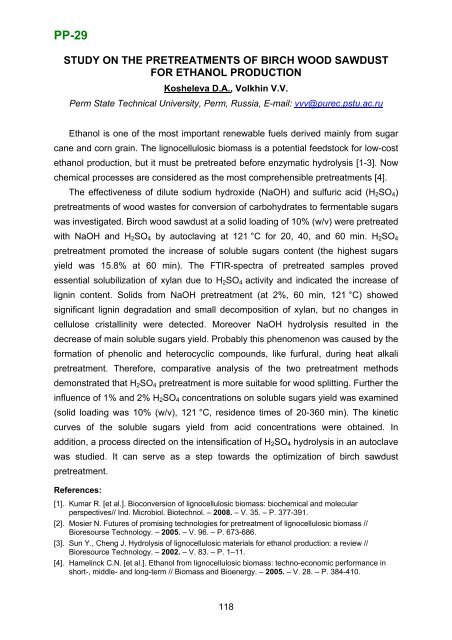Boreskov Institute of Catalysis SB RAS, Novosibirsk, Russia
Boreskov Institute of Catalysis SB RAS, Novosibirsk, Russia
Boreskov Institute of Catalysis SB RAS, Novosibirsk, Russia
- No tags were found...
Create successful ePaper yourself
Turn your PDF publications into a flip-book with our unique Google optimized e-Paper software.
PP-29STUDY ON THE PRETREATMENTS OF BIRCH WOOD SAWDUSTFOR ETHANOL PRODUCTIONKosheleva D.A., Volkhin V.V.Perm State Technical University, Perm, <strong>Russia</strong>, E-mail: vvv@purec.pstu.ac.ruEthanol is one <strong>of</strong> the most important renewable fuels derived mainly from sugarcane and corn grain. The lignocellulosic biomass is a potential feedstock for low-costethanol production, but it must be pretreated before enzymatic hydrolysis [1-3]. Nowchemical processes are considered as the most comprehensible pretreatments [4].The effectiveness <strong>of</strong> dilute sodium hydroxide (NaOH) and sulfuric acid (H 2 SO 4 )pretreatments <strong>of</strong> wood wastes for conversion <strong>of</strong> carbohydrates to fermentable sugarswas investigated. Birch wood sawdust at a solid loading <strong>of</strong> 10% (w/v) were pretreatedwith NaOH and H 2 SO 4 by autoclaving at 121 °C for 20, 40, and 60 min. H 2 SO 4pretreatment promoted the increase <strong>of</strong> soluble sugars content (the highest sugarsyield was 15.8% at 60 min). The FTIR-spectra <strong>of</strong> pretreated samples provedessential solubilization <strong>of</strong> xylan due to H 2 SO 4 activity and indicated the increase <strong>of</strong>lignin content. Solids from NaOH pretreatment (at 2%, 60 min, 121 °C) showedsignificant lignin degradation and small decomposition <strong>of</strong> xylan, but no changes incellulose cristallinity were detected. Moreover NaOH hydrolysis resulted in thedecrease <strong>of</strong> main soluble sugars yield. Probably this phenomenon was caused by theformation <strong>of</strong> phenolic and heterocyclic compounds, like furfural, during heat alkalipretreatment. Therefore, comparative analysis <strong>of</strong> the two pretreatment methodsdemonstrated that H 2 SO 4 pretreatment is more suitable for wood splitting. Further theinfluence <strong>of</strong> 1% and 2% H 2 SO 4 concentrations on soluble sugars yield was examined(solid loading was 10% (w/v), 121 °C, residence times <strong>of</strong> 20-360 min). The kineticcurves <strong>of</strong> the soluble sugars yield from acid concentrations were obtained. Inaddition, a process directed on the intensification <strong>of</strong> H 2 SO 4 hydrolysis in an autoclavewas studied. It can serve as a step towards the optimization <strong>of</strong> birch sawdustpretreatment.References:[1]. Kumar R. [et al.]. Bioconversion <strong>of</strong> lignocellulosic biomass: biochemical and molecularperspectives// Ind. Microbiol. Biotechnol. – 2008. – V. 35. – P. 377-391.[2]. Mosier N. Futures <strong>of</strong> promising technologies for pretreatment <strong>of</strong> lignocellulosic biomass //Bioresourse Technology. – 2005. – V. 96. – P. 673-686.[3]. Sun Y., Cheng J. Hydrolysis <strong>of</strong> lignocellulosic materials for ethanol production: a review //Bioresource Technology. – 2002. – V. 83. – P. 1–11.[4]. Hamelinck C.N. [et al.]. Ethanol from lignocellulosic biomass: techno-economic performance inshort-, middle- and long-term // Biomass and Bioenergy. – 2005. – V. 28. – P. 384-410.118
















